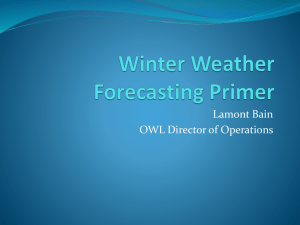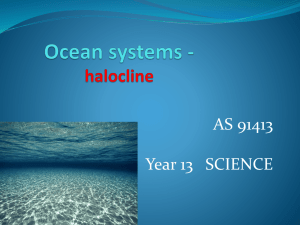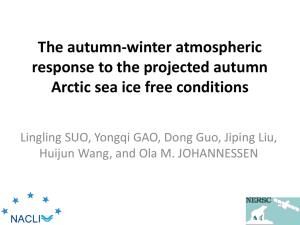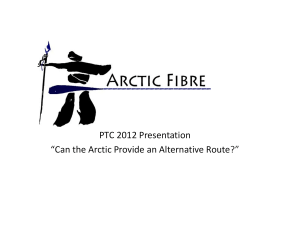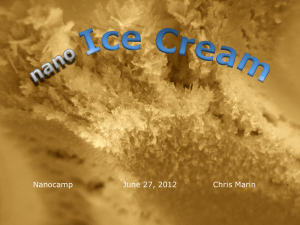Arctic sea ice
advertisement
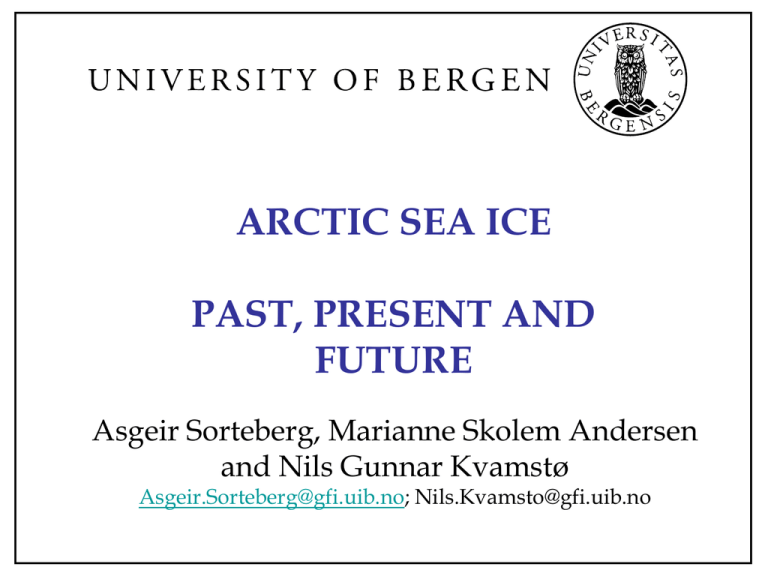
ARCTIC SEA ICE PAST, PRESENT AND FUTURE Asgeir Sorteberg, Marianne Skolem Andersen and Nils Gunnar Kvamstø Asgeir.Sorteberg@gfi.uib.no; Nils.Kvamsto@gfi.uib.no SUMMER SEA ICE EXTENT 1979-2008 IPCC TREND: 15% OBS TREND: 30% QUESTIONS • PREDICTIONS – WILL THIS CONTINUE? • UNDERSTANDING OF THE PROCESSES • ENVIRONMENTAL AND SOCIO-ECONOMIC IMPACT ENERGY RESOURCES 25% of remaining oil/gass reserves estimated to be in the Arctic Estimated reserves Rest of N. Afrika Caspian Sea the world Middle East Arctic 7 1: Barents Sea 2: Southern Kara Sea and West Siberia 3: Northern Kara Sea 4: Laptev Sea 5: East Siberian Sea 6: Chuchi Sea 7: Alaska North Slope 8: East Greenland 6 8 5 1 3 4 2 USGS estimates TRANSPORT 2008 CULTURAL ECOSYSTEMS OBSERVATIONS OF SEA ICE ARCTIC SEA - ICE Arctic sea ice covers an area the size of USA Its separating the relatively warm ocean from a cold atmosphere Maximum sea ice extent is in March minimum in September. NERSC, 2009 ARCTIC SEA ICE EXTENT Various regional time series back to 1900 Good quality satellite measurements of the total extent since 1979 OBSERVED CHANGE IN SUMMER SEA ICE EXTENT CHANGE IN SEPTEMBER ICE EXTENT RELATIVE TO 1979-2000 MEAN (Stroeve et al 2009) Slope = -11.1 (+/- 3.3)% per decade Area of lost sea ice equal to 7 times the area of Norway ARCTIC SEAICE THICKNESS Submarine data (upward looking sonar) • 1958/77 and 1993/97: Thinning of 42% Rothrock et al. (1999) (based on 9 cruises) •1976 and 1996, Thinning of 43% Wadhams and Davis (2001): (based on 2 cruises) •1980 to 2000 Thinning 37% (1.25m) Rothrock et al. (2008) (based on 34 cruises) ARCTIC SEAICE THICKNESS Remote sensing (radar altimetry) • 1993-2001 wintertime No significant thinning Large year to year variability Laxon et al (2003) (ERS data up to 81.58N) • 2003-2008 No significant trend, but 2008 drop Giles et al. (2008) (Envisat data, up to 81.58N) ARCTIC SEAICE THICKNESS Remote sensing (electromagnetic induction (EM) from helicopter) • 2001, 2004, 2007 2007 1m below 2001 and 2004 Haas (2008) (close to North Pole) Haas (2008) ARCTIC SEAICE THICKNESS 1900 1950 Regional extent (Nordic Seas, Russia) Satellite extent Submarine thickness Satellite Thickness (to 81N) EM Thickness (north Pole region) 1975 1990 2000 2010 Reduction Reduction Summer 30%, annual 8% Reduction 1 m (40%) No trend Reduction 1m OBSERVATIONS OF FORCING TERMS OCEANIC ENERGY BUDGET Li +Si Fsfc Rsfc QH QE OE Li So Si Fo Fi Fsfc t t so L – Latent heat; S – sensible heat Forcing terms: • Ice export • Ocean heat transport and heat content • Surface flux Let’s see if there has been changes in some of these terms RADIATION TERMS Reconstructions of the solar irradiance 2 Last 200 years: S d 0.25 to 2 W/m Last 50 years: S d 0.2 W/m 2 THE SOLAR MAGNETIC ACTIVITY CYCLE INSTRUMENTAL MEASUREMENTS EXIST SINCE 1979 (composite of several instruments) Qsolar 0 W/m2 RADIATIVE FORCING Radiative forcing is defined as the change in net irradiance at the tropopause. Net irradiance is the difference between the incoming radiation energy and the outgoing radiation energy in a given climate state AFTER allowing for stratospheric temperatures to readjust to radiative equilibrium, but with surface and tropospheric temperatures and state held fixed at the unperturbed values. [W/m2] Qsolar S d 1 abs stratos 0.05 to 0.2 W/m2 4 RADIATIVE FORCING FROM ATMOSPHERIC GREENHOUSE GASSES RADIATIVE FORCING LAST 250 YEARS GREENHOUSE GASES: 2.63 W/m2 TROPOSPHERIC OZONE: 0.35 W/m2 SOLAR RADIATION: 0.12 W/m2 STRATOSPHERIC OZONE: -0.05 W/m2 VEGETATION CHANGES: -0.20 W/m2 PARTICLES FROM POLLUTION: -0.50 W/m2 PARTICLES EFFECT ON CLOUDS: -0.70 W/m2 SUM: IPCC, 2007 IPCC., 2007 1.65 W/m2 HOW DOES ATMOSPHERIC ENERGY TRANSPORT AFFECT SEA-ICE? HEAT TRANSPORT ACROSS 60ºN Smedsrud and Sorteberg, 2008 Model study (Andersen and Sorteberg, 2009) indicates that the increased atm. energy flux reduced the sea ice thickness with 20% from 1970-1990 1DICE • 1D model of the Arctic AOI (Barents s. not incl) • Atmosphere is a grey body in LW and transparent in SW • Optical thickness as vertical coordinate • 41 classes of sea ice characterized by Hice, Hsnow, Tice, area • Ocean: 350 m column with mixing at the top (Björk and Söderkvist, 2002) FORCING / PRESCRIPTIONS • Lateral atmospheric and oceanic energy transport • Solar rad at TOA • All precip as snow • Wind • Ice export • River run off • Input: Monthly values • Time step: 1 day (Björk and Söderkvist, 2002) Sensitivity increase A more realistic vertical distribution of the atmospheric energy transport results in a higher sea ice sensitivity to transport anomalies! Accuracy of atmospheric energy transport is important! Andersen and Sorteberg (2009) 13 member ensemble repeated annual cycle in D. dD one month at the time • Larger (non-linear) senstivity for positive summer perturbations • Air temperature is close to melting point in summer → extra energy may melt ice • Larger fraction of open waters and thin sea ice gives a sea ice cover that is more sensitive to anomalies in atmospheric energy transport • → ice-albedo feed-back • Ice-albedo feedback gets stronger and faster with a depth dependent sea-ice albedo Andersen and Sorteberg (2009) Simulated annual sea ice thickness development Atmospheric energy transport Ice export Andersen and Sorteberg (2009) INCREASED NET OCEANIC ENERGY TRANSPORT INTO THE ARCTIC? 80TW 40TW 130TW 5TW 40TW Skagseth, 2008 INCREASED NET OCEANIC ENERGY TRANSPORT INTO THE ARCTIC? Possibly more oceanic heat transport last few years 89N, 166E Warm water into Arctic does not necessarily means more melting. Depends on turbulent mixing Observations indicates that turbulent mixing is low outside shelf areas (Sirevåg, 2008) Model study (Smedsrud and Sorteberg, 2008) indicates that an increase in oceanic heatflow of 40TW (5W/m2) over 10 years reduces the ice thickness with 10-15% INCREASED NET EXPORT OF ICE OUT OF ARCTIC? INCREASED NET EXPORT OF ICE OUT OF ARCTIC? Smedsrud and Sorteberg, 2008 Kwok, 2008 Satellite data shows no clear trend in sea ice export, but maybe large export in 2007/08 Model study (Smedsrud and Sorteberg, 2008) indicates that an increase in ice export of 35% (same as 2007/08 level) over 10 years will reduce ice thickness with 15-20%, but have large impact on year-to-year variability RADIATIVE AND DYNAMICAL FORCINGS 1900 1950 Atmospheric heat transport 1990 2000 2010 Increased Anthropogenic forcing Solar 1975 No trend Increased Increased Oceanic heat transport ? Ice Export ? Reduction No trend Possibly high No trend Possibly high CHANGE IN RADIATIVE FORCINGS SOLAR POSITIVE FORCING LAST 200 YEARS, NO TREND LAST 50 0.05-0.2 W/m2 ANTROPOGENIC POSITIVE FORCING LAST 200 YEARS, STRONG TREND LAST 50 1.5 W/m2 LAST 200, 1 W/m2 LAST 50 DYNAMICALLY INDUCED CHANGES ATMOSPHERIC HEAT TRANSPORT POSSIBLE POSITIVE TREND LAST 50 YEARS (NEGATIVE LAST 20) 4-6 W/m2 LAST 50, -2.5 W/m2 LAST 25 (NB. values not directly comparable to radiative forcing estimates!) OCEANIC HEAT TRANSPORT NO GOOD ESTIMATES OVER LAST 50 YEARS,SOME HIGH VALUES LAST YEARS ICE EXPORT NO GOOD ESTIMATES OVER LAST 50 YEARS,SOME HIGH VALUES LAST YEARS RATE OF THE SEA ICE LOSS THE ENERGY FORCINGS PRECONDITION AND INITIATE THE CHANGES BUT MAGNITUDE AND TIME SCALE OF THE FOLLOWING CHANGES ARE MOSTLY RELATED TO THE FEEDBACKS MAIN SHORT-TERM FEEDBACKS Water vapor feedback Lapse rate feedback Cloud feedback Surface albedo feedback Geochemical feedbacks Dynamical feedbacks ? 2007(?) THE ALBEDO FEEDBACK CHANGE IN RADIATIVE FORCING CHANGE IN TEMPERATURE CHANGE IN ALBEDO CHANGE IN MELTING IS THIS THE TIPPING POINT? 1979-2008 IPCC TREND: 15% OBS TREND: 30% Is the ice-albedo effect triggering an accelerated climate change with global implications? FRAMEWORK 1. A change in GHG results in an imbalance/forcing Q 2. The temperature responds ∆Ts to restore balance Q TS TS Q i i LTOA Space Atmosphere Surface S0 1 p 4 CO2 +ΔCO2 TA4 Climate Feedbacks Ts ,eq Q Planck Lapse water cloud albedo -3.2 -0.84 1.80 0.68 0.26 Planck Change in atmospheric temperature profile Water Vapor Clouds Albedo (snow, ice) With albedo feedback 40% from snow 35% Arctic sea ice 25% from Antarctic ice Ts,eq 2.8 C Without albedo feedback Ts,eq 2.4 C Without arctic ice albedo feedback Ts,eq 2.65 C Values from Soden and Held., 2006 SUMMARY PRESENT SITUATION • SUMMER ICE EXTENT REDUCED TWICE AS FAST AS PROJECTED BY IPCC LAST 30 YEARS • ICE THICKNESS LOSS IN PROBABLY LARGE, BUT UNCERTAIN • LONG TERM ICE LOSS PROBABLY DUE TO INCREASED LONGWAVE RADIATIVE FORCING AND INCREASED AND DIFFERENTLY DISTRIBUTED ATMOSPHERIC ENERGY TRANSPORT • NON LINEARITIES IN ALBEDO FEEDBACK MAY BE IMPORTANT FOR EXTREME CHANGES IN EXTENT LAST FEW YEARS • INCREASED ICE EXPORT MAY BE IMPORTANT • TOO EARLY TO CONCLUDE THAT IPCC ESTIMATES ARE TOTALLY OFF, NEXT 5-10 YEARS WILL GIVE GOOD INDICATIONS SUMMARY FUTURE LONG-TERM: CONTINUED LOSS DUE TO LONGWAVE RADIATIVE FORCING NEXT DECADE: OPTION I: PARTIAL RECOVERY IF ICE EXPORT AND OCEANIC/ATM HEAT TRANSPORT STAYS NORMAL OPTION II: CONTINUED STRONG REDUCTION DUE TO NON LINEAR ALBEDO FEEDBACK OR IF ICE EXPORT AND OCEANIC/ATM HEAT TRANSPORT STAYS STRONGER THAN NORMAL SUMMARY GLOBAL IMPLICATIONS ARCTIC SEA ICE IS IMPORTANT FOR ARCTIC ECOSYSTEM AND CULTURE , PROBABLY NOT VERY IMPORTANT FOR THE GLOBE That’s all folks!…




